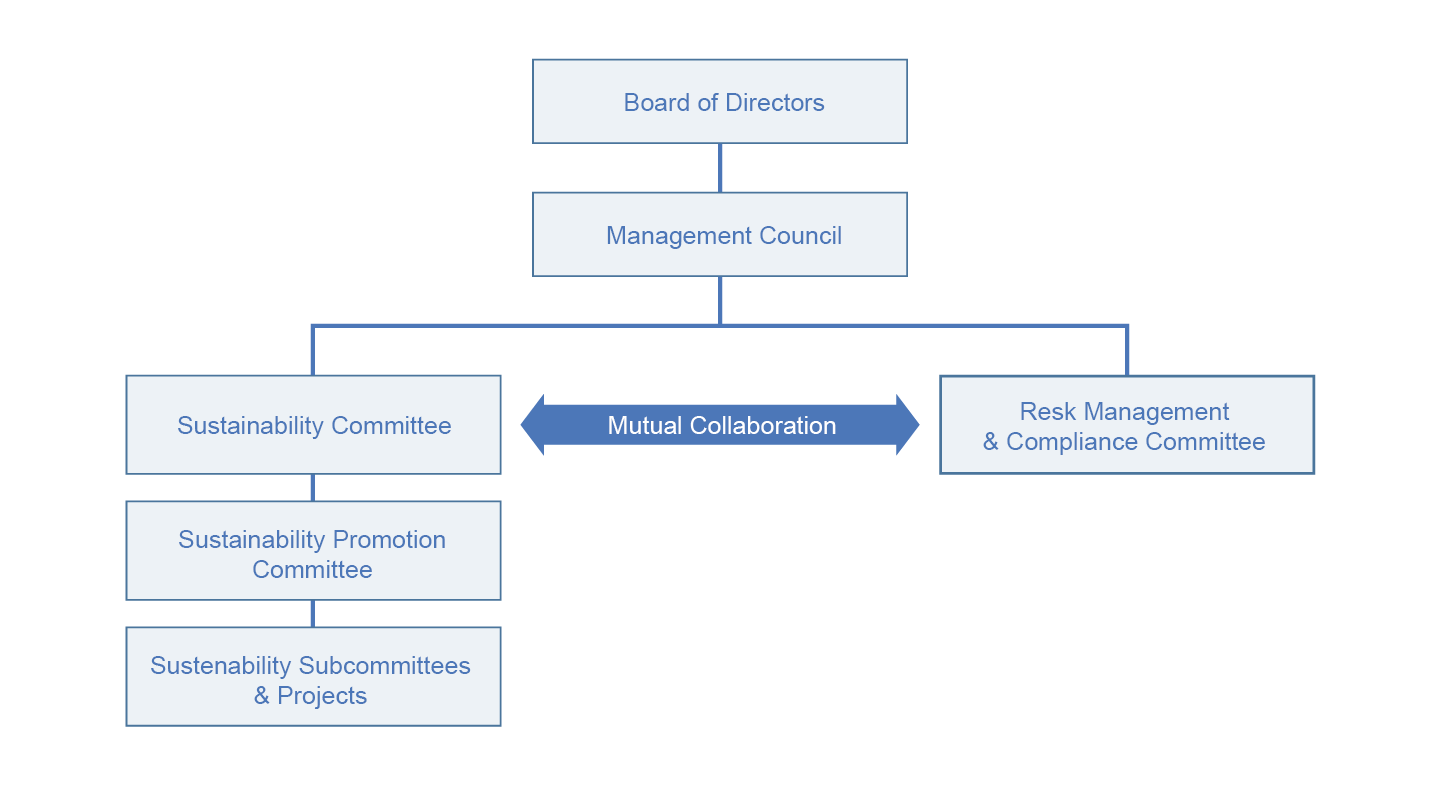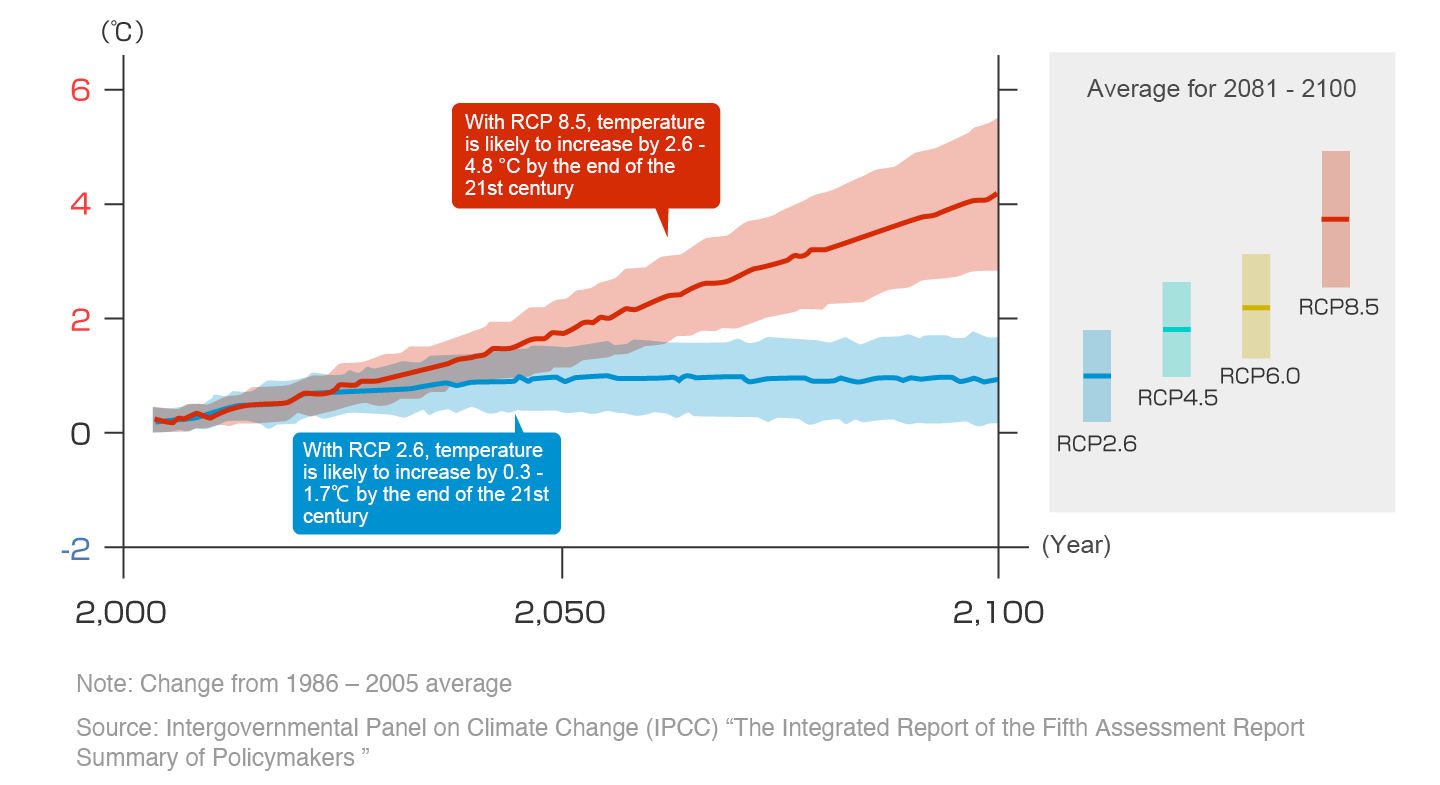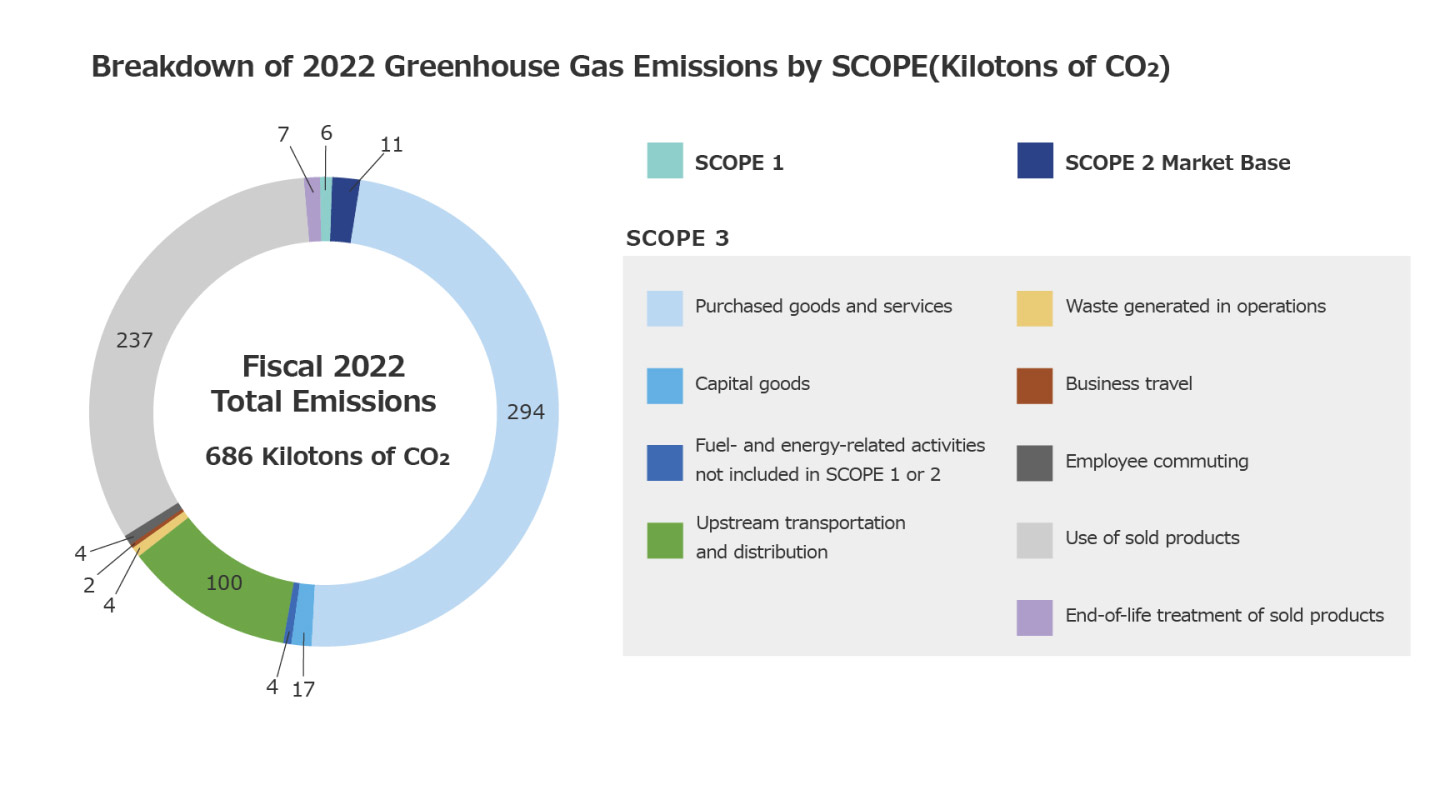Initiatives to Address Climate Change
Lower the Overall Environmental Impact of Business Operations
Our beauteous global environment is the source of healthy lives for all of us. In addition, because many of the ingredients in cosmetics are obtained from nature, we benefit from the natural environment every day we do business. The KOSÉ Group is grateful for this benefit and therefore believes that it has a responsibility to reduce its environmental impact as much as possible to preserve nature—in other words, the global environment. We are now accelerating our initiatives to respond to the particularly pressing issue of climate change.
The KOSÉ Group conducted a material analysis of issues related to the social structure and environment in which it operates. As a result of the findings, we positioned addressing the environment and climate change as an essential management issue in our efforts to drive business growth while helping achieve a sustainable society under the KOSÉ Sustainability Plan, which sets out the entire Group’s sustainability initiatives and targets up to 2030. In October 2020, we announced our support for the recommendations of the Task Force on Climate-related Financial Disclosures (TCFD), and joined the TCFD Consortium, an organization of Japanese companies and other institutions that support the TCFD recommendations.
Based on the TCFD recommendations, we will disclose information to stakeholders on the business risks and opportunities caused by climate change from the four perspectives of governance, strategy, risk management and indexes/goals. We will also continue to make Group-wide efforts to reduce CO2 emissions.
Governance and Risk Management
The KOSÉ Group views sustainability-related issues as management issues, and has established a system for promoting solutions to such issues. Specifically, we established the Sustainability Committee chaired by the President & CEO. This committee proposes sustainability strategies to and receives approval from the Management Committee, and then reports the results to the Board of Directors. As chairperson, the President & CEO is also responsible for evaluating and monitoring issues related to climate change. In addition, we have established subcommittees and projects for individual themes to promote more effective cross-departmental activities.
For organizational risks related to climate change, the Risk Management and Compliance Committee, which oversees enterprise risk management, identifies and assesses risks at the corporate level. Among them we have made climate change an essential factor in our consideration of energy usage, CO2 emissions, water consumption, and wastewater. We take into account physical risks caused by climate change in our business continuity plan. The Sustainability Committee and the Risk Management and Compliance Committee are monitoring climate change-related issues based on these frameworks.

Corporate Governance
Details of the Corporate Governance Sustainability Promotion System
Strategy (Scenario analysis)
The KOSÉ Group conducted scenario analysis to examine the transition risks and physical risks associated with climate change. In this analysis, we evaluate the financial impact of climate change under the scenarios of 1.5˚C/2˚C and 4˚C rise in average global temperatures and disclose information on corporate initiatives. We also use this information to study management strategies to realize the future of society and the earth.

In terms of scenario analyses, we identified risks and opportunities in procurement and demand for our products and services not just in the short term, but also with a medium- to-long-term view toward 2030 and beyond, based on the KOSÉ Sustainability Plan. Furthermore, of these high-priority factors, we identify those with the greatest physical and transition impact and evaluate the potential impact of climate change on the KOSÉ Group. We also analyze the degree of financial impact of risks and opportunities.
In fiscal 2021 we also examined our countermeasures. For example, in terms of raw material procurement risk due to climate change, one approach to reducing risk is to engage with suppliers to promote research and development into low-cost raw materials. In addition, we deemed collaboration with other companies, in-licensing of advanced technology, and the promotion of new sales methods to be effective for developing and expanding products and services with reduced environmental impact. We believe we can reduce the risks and expand the opportunities that we have uncovered by promoting the KOSÉ Sustainability Plan.
| 1.5℃/2℃scenario | 4°C scenario | |
| Social change |
Strengthening regulations for a decarbonized society
|
Physical risks across the value chain make a greater impact
|
| Impact on business |
Accelerating expectations from the society towards a decarbonized society for companies
|
Increased need of a response to BCP and disaster resilience
|
*See 1.5˚C/2˚C (SSP1-1.9 scenario) and 4°C (SSP5-8.5 scenario) of the SSP scenarios in the Sixth Assessment Report of the IPCC (Intergovernmental Panel on Climate Change). See also SDS and NZE2050 for 1.5˚C/2˚C scenarios.
The KOSÉ Group’s Risks and Opportunities
| Analysis | Risks/Opportunities | Effect | Size of Impact on KOSÉ | Summary | Countermeasures | |
| 1.5℃/ 2℃ |
4°C | |||||
| Transition Risks | Shift in consumer demand to environmentally friendly products; decline in reputation due to passive response | Decrease in sales | ++ | - | In the 1.5℃/2℃ scenario, a passive environmental response would lead to lower sales of our products as environmental awareness among consumers increases. | • Strengthen the development of environmentally friendly products such as those that are low-carbon, conserve water, reduce plastic or use sustainable materials
• Consider and promote product development, sales methods, etc. that use advance technologies |
| Stronger restrictions on greenhouse gas emissions; introduction of carbon pricing (affecting KOSÉ and suppliers) | Increase in costs | ++ | - | In the 1.5℃/2℃ scenario, the imposition of a carbon tax, including on suppliers, would lead to increases in our operating and procurement costs. | • Set medium-term emissions reduction targets and implement reduction measures based on SBT certification
• Formulate capital investment plans related to environmental considerations (e.g., sequential replacement of energy-saving equipment) |
|
| Substitution of plastic materials due to introduction of restrictions on plastics | Increase in costs | ++ | - | In the 1.5℃/2℃ scenario, stronger plastic regulations would make it necessary to procure biomass plastics and recycled plastics, leading to an increase in costs. | • Reduce plastics and adopt the use of sustainable materials
• Develop regulation-compliant materials and investigate building a recycling system |
|
| Production restrictions due to the introduction of restrictions on intake and drainage | Decrease in sales | + | ++ | Water stress increases and the introduction of related water intake restrictions in the regions where we operate as a result of climate change, could lead to lost sales opportunities due to suspension of production operations. This impact would likely occur in the 1.5℃/2℃ scenario, but we assume it would be even more significant in the 4°C scenario. | • Achieve further water use efficiencies (e.g., conservation, consider introducing a water recycling system) | |
| Physical Risks | Increase in raw material procurement risk due to climate change | Increase in costs | + | ++ | If the global yields of palm oil and other raw materials used in our products and containers change as a result of rising temperatures, our procurement costs could also change. | • For possible raw materials cost increases, implement joint purchasing with the Group companies and other companies
• Develop and procure alternative raw materials through supplier engagement |
| Suspension of production or logistics operations due to damage from floods or other disasters | Decrease in sales | + | ++ | If natural disasters such as flooding affect our production and logistics bases, sales of our products could decrease due to shutdowns. | • Strengthen our business continuity plan (BCP) response (Study how to respond to an environment expected to further deteriorate. Make use of solutions for adapting to climate change.) | |
| Damage to production facilities and supply chain disruptions caused by abnormal weather | Decrease in sales Increase in costs | + | ++ | If the impact of global warming causes damage to any of our factories, costs such as repair and rebuilding expenses could arise. If the production and logistics bases of suppliers are similarly affected by natural disasters, there is a risk that the supply of our products could be interrupted. | • Strengthen our BCP response (Study how to respond to an environment expected to further deteriorate. Decentralize manufacturing.)
• Establish a disaster-resilient supply chain system (e.g., robust BCPs at major suppliers, multiple procurement sources) |
|
| Opportunities | Increased demand for sunscreen and UV protection products due to increasing UV exposure | Increase in sales | + | ++ | If UV exposure in daily life increases, the number of people who need UV protection products and the frequency of use could increase, resulting in increased sales of those products. | •Active development and positioning of UV care products, etc. •Strengthened appeal to consumers for habitual use of sunscreen products |
| Increased demand for cooling products and makeup smudging prevention products due to rising temperatures | Increase in sales | + | ++ | In cosmetics-related products such as skin lotion and foundation, if needs for products that provide a cooling sensation and prevent makeup from smudging increase along with rising temperatures, sales of those products could increase. | •Active development of products that provide a cooling sensation or prevent makeup from smudging | |
| Improvement of brand value due to reduction of the environmental footprint of our products | Increase in sales | ++ | - | As environmental awareness increases throughout society, our ability to achieve and publicize a reduction in our environmental footprint could have a positive effect in marketing. | • Respond to low-carbon product requirements, etc. (e.g., calculate carbon footprint of each product, develop products that save water at the time of use) | |
| Development and expansion of products and services with reduced environmental impact | Increase in sales | ++ | - | An increase in the perceived added value of providing low-carbon and non-plastic products and services could have a positive effect on revenue. | • Be a source of adaptable products (ethical consumption, etc.)
• Promote product development and sales methods through alliances and the use advanced technologies (beauty partnerships) • Strengthen development of environmentally friendly products that are low-carbon, have less plastic, use sustainable materials, etc. • Establish sales methods that proactively incorporate the latest digital technologies |
|
| Improved cost competitiveness from renewable energy and energy-saving equipment | Decrease in costs | + | ++ | The purchase of renewable energy and the introduction of energy-saving equipment will lead to a reduction in the company's energy costs. Especially in the 1.5℃/2℃ scenario, the cost benefits of renewable energy procurement occur by reducing the price of renewable energy procurement while the price of electricity is higher than now. | • Procure renewable energy (various power-purchasing agreements, etc.).
• Develop renewable energy with in-house power generation and consumption |
|
Note:-:minimal impact +:some impact ++:substantial impact
Specific Activities

KOSE Gunma Factory
At the Gunma Factory, one of our main production facilities, we switched all of the electricity we purchase to electricity from renewable energy sources from January 2021. Over a full year, this will be equivalent to approximately 23% of the amount of greenhouse gas emissions from energy and purchased electricity at all KOSÉ Group locations, using fiscal 2018 as the base year.
At KOSÉ SALES CO., LTD., we are promoting car sharing to reduce the number of sales vehicles used. We also conducted a fundamental review of sales operations, and are taking steps to achieve further reductions.
We are also making efforts to reduce the environmental impact of our products and advertisements.
Initiatives in Production
Initiatives in Advertising, Sales and Offices
Initiatives in Products
Indicators and Targets
Based on the results of the scenario analysis, the KOSÉ Group realized it was critical to set some bold targets for CO2 emission reduction in its operations to contribute to keeping the rise in average atmospheric temperatures within 2°C.
The KOSÉ Group has set targets for reducing CO2 emissions by 2030, including a 55% reduction in CO2 emissions from energy and electricity used by the Group (Scope 1 and 2) (for SBT 1.5 °C Target Certification*1) and a 30% reduction in CO2 emissions from the entire value chain (Scope 3) (for SBT Certification*2) (both compared to FY2018). In order to further strengthen our response to the climate change that the world is facing, we have established a new goal of achieving carbon neutrality by achieving net-zero CO2 emissions by 2040. From its business activities to the entire value chain, the KOSÉ Group is actively working to reduce CO2 emissions from a wide range of perspectives.
*1:Targets advocated by the Science Based Targets initiative (SBTi), which are consistent with the standards required by the Paris Agreement.Set based on scientific evidence to limit the increase in global average temperature to 1.5°C above pre-industrial levels.
*2:Certification by the international initiative “SBTi (Science Based Targets initiative)”
| 2030 Target | Reduce Scope 1 and 2 CO2 emissions by 55% (compared to 2018) |
| Reduce Scope 3 CO2 emissions by 30% (compared to 2018) | |
| 2040 Target | Achieve carbon neutrality (Scope 1 and 2) |
The KOSÉ Group is now carrying out ambitious initiatives to curb CO2 emissions with a broad perspective, from our own business activities to the entire value chain. We remain dedicated to taking effective action on climate change and a range of other social issues, and thereby help realize a healthy future for the Earth in which everyone can live with peace of mind.

Details of CO2 emissions:Sustainability Data
For the Global Environment
Top
Environmental Indicators
Initiatives to Address Climate Change
Low-Carbon Transition Plan
Measures for Circular Economy
Efforts related to products
Efforts in manufacturing
Efforts at offices, logistics operations, and shops
Overall data on environmental impact

